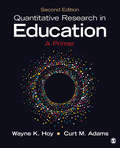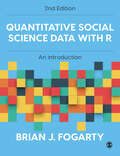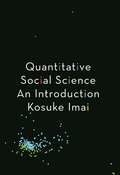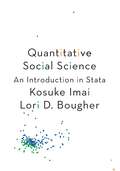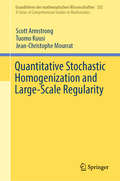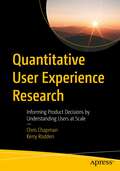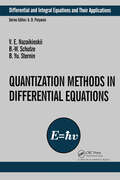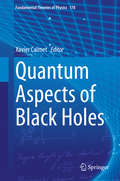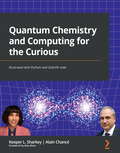- Table View
- List View
Quantitative Research in Education: A Primer
by Wayne K. Hoy Curt M. Adams"The book provides a reference point for beginning educational researchers to grasp the most pertinent elements of designing and conducting research…" —Megan Tschannen-Moran, The College of William & Mary Quantitative Research in Education: A Primer, Second Edition is a brief and practical text designed to allay anxiety about quantitative research. Award-winning authors Wayne K. Hoy and Curt M. Adams first introduce readers to the nature of research and science, and then present the meaning of concepts and research problems as they dispel notions that quantitative research is too difficult, too theoretical, and not practical. Rich with concrete examples and illustrations, the Primer emphasizes conceptual understanding and the practical utility of quantitative methods while teaching strategies and techniques for developing original research hypotheses. The Second Edition includes suggestions for empirical investigation and features a new section on self-determination theory, examples from the latest research, a concluding chapter illustrating the practical applications of quantitative research, and much more. This accessible Primer is perfect for students and researchers who want a quick understanding of the process of scientific inquiry and who want to learn how to effectively create and test ideas.
Quantitative Research in Education: A Primer
by Wayne K. Hoy Curt M. Adams"The book provides a reference point for beginning educational researchers to grasp the most pertinent elements of designing and conducting research…" —Megan Tschannen-Moran, The College of William & Mary Quantitative Research in Education: A Primer, Second Edition is a brief and practical text designed to allay anxiety about quantitative research. Award-winning authors Wayne K. Hoy and Curt M. Adams first introduce readers to the nature of research and science, and then present the meaning of concepts and research problems as they dispel notions that quantitative research is too difficult, too theoretical, and not practical. Rich with concrete examples and illustrations, the Primer emphasizes conceptual understanding and the practical utility of quantitative methods while teaching strategies and techniques for developing original research hypotheses. The Second Edition includes suggestions for empirical investigation and features a new section on self-determination theory, examples from the latest research, a concluding chapter illustrating the practical applications of quantitative research, and much more. This accessible Primer is perfect for students and researchers who want a quick understanding of the process of scientific inquiry and who want to learn how to effectively create and test ideas.
Quantitative Risk Management in Agricultural Business (Springer Actuarial)
by Peng Liu Hirbod Assa Simon WangThis open access volume explores the cutting edge of quantitative methods in agricultural risk management and insurance. Composed of insightful articles authored by field experts, focusing on innovation, recent advancements, and the use of technology and data sciences, it bridges the gap between theory and practice through empirical studies, concrete examples and case analyses. Evolving challenges in risk management have called for the development of new, groundbreaking models. Beyond presenting the theoretical foundations of these models, this book discusses their real-world applications, providing tangible insights into how innovative modeling can elevate risk management strategies in the agricultural sector. The latest risk management tools incorporate novel concepts such as index insurance, price index risk management frameworks and risk pools. The practical implications of these approaches are investigated, and their impact on contemporary agricultural risk mitigation and insurance practices is examined. Field experiences illustrate the implementation of these tools and their resulting outcomes. Modern data analysis techniques in agricultural risk and insurance include machine learning, spatial analysis, text analysis, and deep learning. In addition to scrutinizing these ideas, the authors introduce an economic perspective towards risk, highlighting areas that have developed thanks to technological progress. Examples illustrate how these combined methodologies contribute to informed decision-making in agriculture, and their potential benefits and challenges are considered. This carefully compiled volume will be a valuable reference for researchers, practitioners, and students intrigued by the dynamic intersection of agricultural risk management and insurance practices.
Quantitative Social Science Data with R: An Introduction
by Brian J FogartyRelevant, engaging, and packed with student-focused learning features, this book provides the basic step-by-step introduction to quantitative research and data every student needs. Gradually introducing applied statistics and the language and functionality of R and R Studio software, it uses examples from across the social sciences to show students how to apply abstract statistical and methodological principles to their own work. Maintaining a student-friendly pace, it goes beyond a normal introductory statistics book and shows students where data originates and how to: - Understand and use quantitative data to answer questions - Approach surrounding ethical issues - Collect quantitative data - Manage, write about, and share the data effectively Supported by incredible digital resources with online tutorials, videos, datasets, and multiple choice questions, this book gives students not only the tools they need to understand statistics, quantitative data, and R software, but also the chance to practice and apply what they have learned.
Quantitative Social Science Data with R: An Introduction
by Brian J FogartyRelevant, engaging, and packed with student-focused learning features, this book provides the basic step-by-step introduction to quantitative research and data every student needs. Gradually introducing applied statistics and the language and functionality of R and R Studio software, it uses examples from across the social sciences to show students how to apply abstract statistical and methodological principles to their own work. Maintaining a student-friendly pace, it goes beyond a normal introductory statistics book and shows students where data originates and how to: - Understand and use quantitative data to answer questions - Approach surrounding ethical issues - Collect quantitative data - Manage, write about, and share the data effectively Supported by incredible digital resources with online tutorials, videos, datasets, and multiple choice questions, this book gives students not only the tools they need to understand statistics, quantitative data, and R software, but also the chance to practice and apply what they have learned.
Quantitative Social Science: An Introduction
by Kosuke ImaiAn introductory textbook on data analysis and statistics written especially for students in the social sciences and allied fieldsQuantitative analysis is an increasingly essential skill for social science research, yet students in the social sciences and related areas typically receive little training in it—or if they do, they usually end up in statistics classes that offer few insights into their field. This textbook is a practical introduction to data analysis and statistics written especially for undergraduates and beginning graduate students in the social sciences and allied fields, such as economics, sociology, public policy, and data science.Quantitative Social Science engages directly with empirical analysis, showing students how to analyze data using the R programming language and to interpret the results—it encourages hands-on learning, not paper-and-pencil statistics. More than forty data sets taken directly from leading quantitative social science research illustrate how data analysis can be used to answer important questions about society and human behavior.Proven in the classroom, this one-of-a-kind textbook features numerous additional data analysis exercises and interactive R programming exercises, and also comes with supplementary teaching materials for instructors.Written especially for students in the social sciences and allied fields, including economics, sociology, public policy, and data scienceProvides hands-on instruction using R programming, not paper-and-pencil statisticsIncludes more than forty data sets from actual research for students to test their skills onCovers data analysis concepts such as causality, measurement, and prediction, as well as probability and statistical toolsFeatures a wealth of supplementary exercises, including additional data analysis exercises and interactive programming exercisesOffers a solid foundation for further studyComes with additional course materials online, including notes, sample code, exercises and problem sets with solutions, and lecture slidesLooking for a more accessible introduction? Consider Data Analysis for Social Science by Elena Llaudet and Kosuke Imai, which teaches from scratch and step-by-step the fundamentals of survey research, predictive models, and causal inference. It covers descriptive statistics, the difference-in-means estimator, simple linear regression, and multiple linear regression.
Quantitative Social Science: An Introduction in Stata
by Kosuke Imai Lori D. BougherThe Stata edition of the groundbreaking textbook on data analysis and statistics for the social sciences and allied fieldsQuantitative analysis is an increasingly essential skill for social science research, yet students in the social sciences and related areas typically receive little training in it—or if they do, they usually end up in statistics classes that offer few insights into their field. This textbook is a practical introduction to data analysis and statistics written especially for undergraduates and beginning graduate students in the social sciences and allied fields, such as business, economics, education, political science, psychology, sociology, public policy, and data science.Quantitative Social Science engages directly with empirical analysis, showing students how to analyze data using the Stata statistical software and interpret the results—it emphasizes hands-on learning, not paper-and-pencil statistics. More than fifty data sets taken directly from leading quantitative social science research illustrate how data analysis can be used to answer important questions about society and human behavior.Proven in classrooms around the world, this one-of-a-kind textbook features numerous additional data analysis exercises, and also comes with supplementary teaching materials for instructors.Written especially for students in the social sciences and allied fields, including business, economics, education, psychology, political science, sociology, public policy, and data scienceProvides hands-on instruction using Stata, not paper-and-pencil statisticsIncludes more than fifty data sets from actual research for students to test their skills onCovers data analysis concepts such as causality, measurement, and prediction, as well as probability and statistical toolsFeatures a wealth of supplementary exercises, including additional data analysis exercises and interactive programming exercisesOffers a solid foundation for further studyComes with additional course materials online, including notes, sample code, exercises and problem sets with solutions, and lecture slides
Quantitative Sociodynamics
by Dirk HelbingThis new edition of Quantitative Sociodynamics presents a general strategy for interdisciplinary model building and its application to a quantitative description of behavioral changes based on social interaction processes. Originally, the crucial methods for the modeling of complex systems (stochastic methods and nonlinear dynamics) were developed in physics and mathematics, but they have very often proven their explanatory power in chemistry, biology, economics and the social sciences as well. Quantitative Sociodynamics provides a unified and comprehensive overview of the different stochastic methods, their interrelations and properties. In addition, it introduces important concepts from nonlinear dynamics (e.g. synergetics, chaos theory). The applicability of these fascinating concepts to social phenomena is carefully discussed. By incorporating decision-theoretical approaches, a fundamental dynamic model is obtained, which opens new perspectives in the social sciences. It includes many established models as special cases, e.g. the logistic equation, the gravity model, some diffusion models, evolutionary game theory and social field theory. Moreover, it implies numerous new results and is relevant for various application areas, such as opinion formation, migration, the self-organization of behavioral conventions, and the behavior of customers and voters. Theoretical results are complemented and illustrated by numerous computer simulations. Quantitative Sociodynamics is relevant both for social scientists and natural scientists who are interested in the application of stochastic and synergetics concepts to interdisciplinary topics.
Quantitative Stochastic Homogenization and Large-Scale Regularity (Grundlehren der mathematischen Wissenschaften #352)
by Scott Armstrong Tuomo Kuusi Jean-Christophe MourratThe focus of this book is the large-scale statistical behavior of solutions of divergence-form elliptic equations with random coefficients, which is closely related to the long-time asymptotics of reversible diffusions in random media and other basic models of statistical physics. Of particular interest is the quantification of the rate at which solutions converge to those of the limiting, homogenized equation in the regime of large scale separation, and the description of their fluctuations around this limit. This self-contained presentation gives a complete account of the essential ideas and fundamental results of this new theory of quantitative stochastic homogenization, including the latest research on the topic, and is supplemented with many new results. The book serves as an introduction to the subject for advanced graduate students and researchers working in partial differential equations, statistical physics, probability and related fields, as well as a comprehensive reference for experts in homogenization. Being the first text concerned primarily with stochastic (as opposed to periodic) homogenization and which focuses on quantitative results, its perspective and approach are entirely different from other books in the literature.
Quantitative Tamarkin Theory (CRM Short Courses)
by Jun ZhangThis textbook offers readers a self-contained introduction to quantitative Tamarkin category theory. Functioning as a viable alternative to the standard algebraic analysis method, the categorical approach explored in this book makes microlocal sheaf theory accessible to a wide audience of readers interested in symplectic geometry. Much of this material has, until now, been scattered throughout the existing literature; this text finally collects that information into one convenient volume. After providing an overview of symplectic geometry, ranging from its background to modern developments, the author reviews the preliminaries with precision. This refresher ensures readers are prepared for the thorough exploration of the Tamarkin category that follows. A variety of applications appear throughout, such as sheaf quantization, sheaf interleaving distance, and sheaf barcodes from projectors. An appendix offers additional perspectives by highlighting further useful topics. Quantitative Tamarkin Theory is ideal for graduate students interested in symplectic geometry who seek an accessible alternative to the algebraic analysis method. A background in algebra and differential geometry is recommended.This book is part of the "Virtual Series on Symplectic Geometry"http://www.springer.com/series/16019
Quantitative Techniques in Business, Management and Finance: A Case-Study Approach
by D P Kothari Umeshkumar Dubey G K AwariThis book is especially relevant to undergraduates, postgraduates and researchers studying quantitative techniques as part of business, management and finance. It is an interdisciplinary book that covers all major topics involved at the interface between business and management on the one hand and mathematics and statistics on the other. Managers and others in industry and commerce who wish to obtain a working knowledge of quantitative techniques will also find this book useful.
Quantitative Tourism Industry Analysis
by Tadayuki HaraQuantitative Tourism Industry Analysis is the first book to deal with the input-output, social accounting matrix in a way which readers from a non-economics or non-mathematical background can follow, in order to understand how useful their application would be for tourism industry analysis. It acquaints readers with useful applications of economic modelling without the unnecessary burden of higher algebra, so that they will understand concepts of the economics measurement system, Tourism Satellite Accounts (TSA) methodology.Quantitative Tourism Industry Analysis offers a new set of economic tools for tourism policy analysis, ideal for those with a non-mathematical background.
Quantitative Tourism Research in Asia: Current Status And Future Directions (Perspectives on Asian Tourism)
by Sajad RezaeiThe purpose of this book is twofold. First, this book is an attempt to map the state of quantitative research in Asian tourism and hospitality context and provide a detailed description of the design, implementation, application, and challenges of quantitative methods in tourism in Asia. Second, this book aims to contribute to the tourism literature by discussing the past, current and future quantitative data analysis methods.The book offers new insights into well-established research techniques such as regression analysis, but goes beyond first generation data analysis techniques to introduce methods seldom – if ever – used in tourism and hospitality research. In addition to investigating existing and novel research techniques, the book suggests areas for future studies. In order to achieve its objectives the analysis is split into three main sections: understanding the tourism industry in Asia; the current status of quantitative data analysis; and future directions for Asian tourism research.
Quantitative Trading: Algorithms, Analytics, Data, Models, Optimization
by Tze Leung Lai Howard Shek Samuel Po-Shing Wong Xin GuoThe first part of this book discusses institutions and mechanisms of algorithmic trading, market microstructure, high-frequency data and stylized facts, time and event aggregation, order book dynamics, trading strategies and algorithms, transaction costs, market impact and execution strategies, risk analysis, and management. The second part covers market impact models, network models, multi-asset trading, machine learning techniques, and nonlinear filtering. The third part discusses electronic market making, liquidity, systemic risk, recent developments and debates on the subject.
Quantitative User Experience Research: Informing Product Decisions by Understanding Users at Scale
by Chris Chapman Kerry RoddenThis book is your definitive guide to the rapidly growing role of Quantitative User Experience (Quant UX) Research in product development. The book provides an overview of the skills you need on the job, presents hands-on projects with reusable code, and shares advice on starting and developing a career. The book goes beyond basic skills to focus on what is unique to Quant UX. The authors are two of the most widely recognized practitioners in Quant UX research, and this book shares insights from their combined decades of experience. Organizations today have more data about user needs and behaviors than ever before. With this large-scale data, Quant UX researchers work to understand usage patterns, measure the impact of design changes, and inform strategic decisions. In the Quant UX role, interdisciplinary researchers apply analytical skills to uncover user needs, inform engineering and design, answer strategic business questions, and optimize software and hardware products for human interaction. This book provides guidance around customer satisfaction surveys, understanding user behavior from log analysis, and the statistical methods that are commonly used to assess user outcomes. What You Will LearnDiscover the role of Quantitative User Experience (Quant UX) researchUnderstand how Quant UX research differs from other disciplines such as data sciencePlan common research projects and know how to achieve successPosition Quant UX activities in product development, engineering, and UX organizationsApply the HEART framework to measure user experience outcomesEvaluate your skills and potential to be hired as a Quant UX researcherKnow what to expect during job interviewsFind examples of common Quant UX projects with shared R code and data setsWho This Book Is ForPractitioners and managers who seek a comprehensive guide to the new field of Quantitative User Experience Research. Readers will understand the Quant UX role, build research skills, find examples of hands-on code and analyses, learn about UX organizations and stakeholders, and receive advice on job interviews and career paths. Data scientists, social scientists, and other researchers will learn how their skills transfer to Quant UX, where they can help teams build better, more successful products.
Quantitative and Qualitative Methods in Psychotherapy Research (Explorations in Mental Health)
by Wolfgang Lutz Sarah KnoxIn this collection, international contributors come together to discuss how qualitative and quantitative methods can be used in psychotherapy research. The book considers the advantages and disadvantages of each approach, and recognises how each method can enhance our understanding of psychotherapy. Divided into two parts, the book begins with an examination of quantitative research and discusses how we can transfer observations into numbers and statistical findings. Chapters on quantitative methods cover the development of new findings and the improvement of existing findings, identifying and analysing change, and using meta-analysis. The second half of the book comprises chapters considering how qualitative and mixed methods can be used in psychotherapy research. Chapters on qualitative and mixed methods identify various ways to strengthen the trustworthiness of qualitative findings via rigorous data collection and analysis techniques. Adapted from a special issue of Psychotherapy Research, this volume will be key reading for researchers, academics, and professionals who want a greater understanding of how a particular area of research methods can be used in psychotherapy.
Quantization Methods in the Theory of Differential Equations (Differential and Integral Equations and Their Applications)
by Vladimir E. Nazaikinskii Boris Yu. Sternin B.-W. SchulzeThis volume presents a systematic and mathematically rigorous exposition of methods for studying linear partial differential equations. It focuses on quantization of the corresponding objects (states, observables and canonical transformations) in the phase space. The quantization of all three types of classical objects is carried out in a unified w
Quantization, Geometry and Noncommutative Structures in Mathematics and Physics
by Alexander Cardona Pedro Morales Hernán Ocampo Sylvie Paycha Andrés F. Reyes LegaThis monograph presents various ongoing approaches to the vast topic of quantization, which is the process of forming a quantum mechanical system starting from a classical one, and discusses their numerous fruitful interactions with mathematics. The opening chapter introduces the various forms of quantization and their interactions with each other and with mathematics. A first approach to quantization, called deformation quantization, consists of viewing the Planck constant as a small parameter. This approach provides a deformation of the structure of the algebra of classical observables rather than a radical change in the nature of the observables. When symmetries come into play, deformation quantization needs to be merged with group actions, which is presented in chapter 2, by Simone Gutt. The noncommutativity arising from quantization is the main concern of noncommutative geometry. Allowing for the presence of symmetries requires working with principal fiber bundles in a non-commutative setup, where Hopf algebras appear naturally. This is the topic of chapter 3, by Christian Kassel. Nichols algebras, a special type of Hopf algebras, are the subject of chapter 4, by Nicol#65533;s Andruskiewitsch. The purely algebraic approaches given in the previous chapters do not take the geometry of space-time into account. For this purpose a special treatment using a more geometric point of view is required. An approach to field quantization on curved space-time, with applications to cosmology, is presented in chapter 5 in an account of the lectures of Abhay Ashtekar that brings a complementary point of view to non-commutativity. An alternative quantization procedure is known under the name of string theory. In chapter 6 its supersymmetric version is presented. Superstrings have drawn the attention of many mathematicians, due to its various fruitful interactions with algebraic geometry, some of which are described here. The remaining chapters discuss further topics, as the Batalin-Vilkovisky formalism and direct products of spectral triples. This volume addresses both physicists and mathematicians and serves as an introduction to ongoing research in very active areas of mathematics and physics at the border line between geometry, topology, algebra and quantum field theory.
Quantized Detector Networks: The Theory of Observation (Cambridge Monographs on Mathematical Physics)
by George JaroszkiewiczScientists have been debating the meaning of quantum mechanics for over a century. This book for graduate students and researchers gets to the root of the problem; the contextual nature of empirical truth, the laws of observation and how these impact on our understanding of quantum physics. Bridging the gap between non-relativistic quantum mechanics and quantum field theory, this novel approach to quantum mechanics extends the standard formalism to cover the observer and their apparatus. The author demystifies some of the aspects of quantum mechanics that have traditionally been regarded as extraordinary, such as wave-particle duality and quantum superposition, by emphasizing the scientific principles rather than the mathematical modelling involved. Including key experiments and worked examples throughout to encourage the reader to focus on empirically sound concepts, this book avoids metaphysical speculation and also alerts the reader to the use of computer algebra to explore quantum experiments of virtually limitless complexity.
Quantum Adaptivity in Biology: From Genetics to Cognition
by Andrei Khrennikov Masanari Asano Masanori Ohya Yoshiharu Tanaka Ichiro YamatoThis book examines information processing performed by bio-systems at all scales: from genomes, cells and proteins to cognitive and even social systems. It introduces a theoretical/conceptual principle based on quantum information and non-Kolmogorov probability theory to explain information processing phenomena in biology as a whole. The book begins with an introduction followed by two chapters devoted to fundamentals, one covering classical and quantum probability, which also contains a brief introduction to quantum formalism, and another on an information approach to molecular biology, genetics and epigenetics. It then goes on to examine adaptive dynamics, including applications to biology, and non-Kolmogorov probability theory. Next, the book discusses the possibility to apply the quantum formalism to model biological evolution, especially at the cellular level: genetic and epigenetic evolutions. It also presents a model of the epigenetic cellular evolution based on the mathematical formalism of open quantum systems. The last two chapters of the book explore foundational problems of quantum mechanics and demonstrate the power of usage of positive operator valued measures (POVMs) in biological science. This book will appeal to a diverse group of readers including experts in biology, cognitive science, decision making, sociology, psychology, and physics; mathematicians working on problems of quantum probability and information and researchers in quantum foundations.
Quantum Aspects of Black Holes (Fundamental Theories of Physics #178)
by Xavier CalmetBeginning with an overview of the theory of black holes by the editor, this book presents a collection of ten chapters by leading physicists dealing with the variety of quantum mechanical and quantum gravitational effects pertinent to black holes. The contributions address topics such as Hawking radiation, the thermodynamics of black holes, the information paradox and firewalls, Monsters, primordial black holes, self-gravitating Bose-Einstein condensates, the formation of small black holes in high energetic collisions of particles, minimal length effects in black holes and small black holes at the Large Hadron Collider. Viewed as a whole the collection provides stimulating reading for researchers and graduate students seeking a summary of the quantum features of black holes.
Quantum Chemistry
by M. S. RaoQuantum Chemistry provides a coherent and structured approach in introducing the concept of 'quantum' to the students of quantum mechanics. An attempt is made to bring out the subtleties of quantum mechanics, hidden in its abstract laws and equations, applicable to the atomic domain by showing its relevance to the observable macroscopic world as well. The book will help students dispel the stigma associated with quantum mechanics. The emphasis on conceptual approach provides a platform to stand on, and a stimulus to pursue higher quantum mechanics—the doorway to the all-pervasive quantum world. Print edition not for sale in South Asia (India, Sri Lanka, Nepal, Bangladesh, Pakistan or Bhutan).
Quantum Chemistry and Computing for the Curious: Illustrated with Python and Qiskit® code
by Keeper L. Sharkey Alain Chance Alex KhanAcquire knowledge of quantum chemistry concepts, the postulates of quantum mechanics, and the foundations of quantum computing, and execute illustrations made with Python code, Qiskit, and open-source quantum chemistry packagesKey FeaturesBe at the forefront of a quest for increased accuracy in chemistry applications and computingGet familiar with some open source quantum chemistry packages to run your own experimentsDevelop awareness of computational chemistry problems by using postulates of quantum mechanicsBook DescriptionExplore quantum chemical concepts and the postulates of quantum mechanics in a modern fashion, with the intent to see how chemistry and computing intertwine. Along the way you'll relate these concepts to quantum information theory and computation. We build a framework of computational tools that lead you through traditional computational methods and straight to the forefront of exciting opportunities. These opportunities will rely on achieving next-generation accuracy by going further than the standard approximations such as beyond Born-Oppenheimer calculations.Discover how leveraging quantum chemistry and computing is a key enabler for overcoming major challenges in the broader chemical industry. The skills that you will learn can be utilized to solve new-age business needs that specifically hinge on quantum chemistryWhat you will learnUnderstand mathematical properties of the building blocks of matterRun through the principles of quantum mechanics with illustrationsDesign quantum gate circuit computationsProgram in open-source chemistry software packages such as Qiskit®Execute state-of-the-art-chemistry calculations and simulationsRun companion Jupyter notebooks on the cloud with just a web browserExplain standard approximations in chemical simulationsWho this book is forProfessionals interested in chemistry and computer science at the early stages of learning, or interested in a career of quantum computational chemistry and quantum computing, including advanced high school and college students. Helpful to have high school level chemistry, mathematics (algebra), and programming. An introductory level of understanding Python is sufficient to read the code presented to illustrate quantum chemistry and computing
Quantum Computation and Logic: How Quantum Computers Have Inspired Logical Investigations (Trends in Logic #48)
by Maria Luisa Dalla Chiara Roberto Giuntini Roberto Leporini Giuseppe SergioliThis book provides a general survey of the main concepts, questions and results that have been developed in the recent interactions between quantum information, quantum computation and logic. Divided into 10 chapters, the books starts with an introduction of the main concepts of the quantum-theoretic formalism used in quantum information. It then gives a synthetic presentation of the main “mathematical characters” of the quantum computational game: qubits, quregisters, mixtures of quregisters, quantum logical gates. Next, the book investigates the puzzling entanglement-phenomena and logically analyses the Einstein–Podolsky–Rosen paradox and introduces the reader to quantum computational logics, and new forms of quantum logic. The middle chapters investigate the possibility of a quantum computational semantics for a language that can express sentences like “Alice knows that everybody knows that she is pretty”, explore the mathematical concept of quantum Turing machine, and illustrate some characteristic examples that arise in the framework of musical languages. The book concludes with an analysis of recent discussions, and contains a Mathematical Appendix which is a survey of the definitions of all main mathematical concepts used in the book.
Quantum Computation and Quantum Information
by Michael A. Nielsen Isaac L. ChuangIn this first comprehensive introduction to the main ideas and techniques of quantum computation and information, Michael Nielsen and Isaac Chuang ask the question: What are the ultimate physical limits to computation and communication? They detail such remarkable effects as fast quantum algorithms, quantum teleportation, quantum cryptography and quantum error correction. A wealth of accompanying figures and exercises illustrate and develop the material in more depth. They describe what a quantum computer is, how it can be used to solve problems faster than familiar "classical" computers, and the real-world implementation of quantum computers. Their book concludes with an explanation of how quantum states can be used to perform remarkable feats of communication, and of how it is possible to protect quantum states against the effects of noise.
